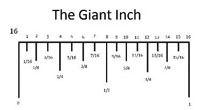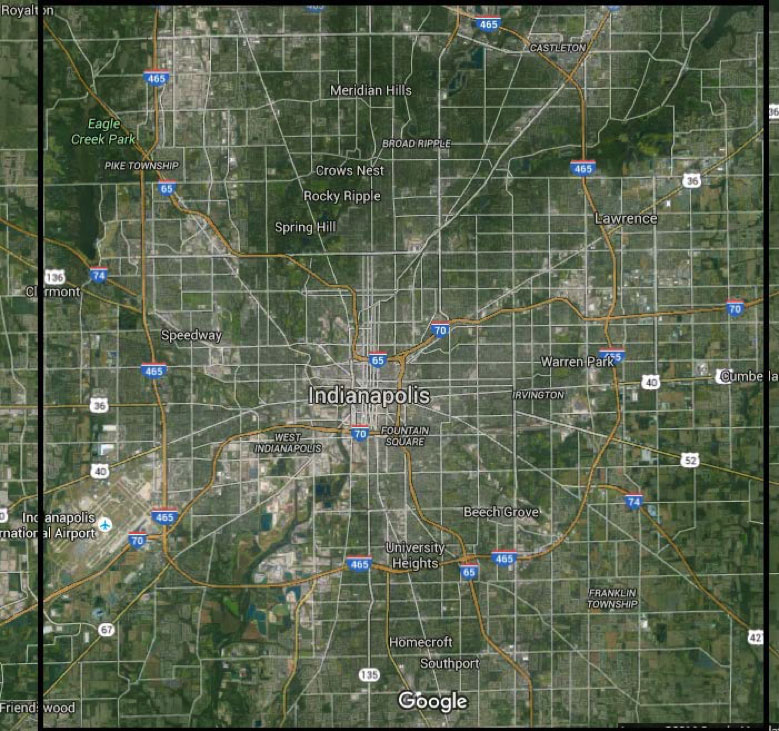Begin by reading the worksheet from the top. “Important information about urban heat islands can be obtained from maps. Before the information on a map can be described and analyzed, it is necessary to have a clear understanding of what the map is about. This is the first step in obtaining information from a map.
“Question One, what is the map about? This involves previewing the map. So we are going to look at these five items: title, symbols, map scale, compass direction, and footnotes, and identify them in a way to understand what the map is about.
“What is the title of this map?”
“Titles are usually found at the top of a map (point to an example in the classroom if you have a map hanging). However, this map does not have a title at the top. What else do we know about titles? They are usually bold and larger than the rest of the text. Where on this map do I find that type of textMake sure to provide enough wait time to allow students a chance to answer.?
This text, Land Surface Temperature (LST) Modeling, is a different color, uppercased and larger than the text below, so this is the title.
“Based upon this title, what is this map about?”
“The title suggests that this map is about the temperature of the surface of the land.
“The next step is decoding the symbols. In order to decode symbols, I must look at the legend or key.
“Where is the legend on this map? And what does it mean?
“The section on the right looks like a legend. The legend shows land surface temperature measured in degrees Fahrenheit. The dark red is 87 degrees to 93 degrees; orange in 85 to 87 degrees; yellow represents 84 to 85 degrees; green is 83 to 84 degrees; light blue is 81 to 83 degrees; and dark blue represents 73-81 degrees. Notice how each color is represented by different rangesMATH: Students can calculate the range of degrees for each color using simple subtraction. Dark Red 6; Orange 2; Yellow 1; Green 1; Light Blue 2; Dark Blue 8 of temperature, also called intervalMATH: There are four types of measurement scales: nominal, ordinal, interval and ratio. data. The legend shows the data being classifiedGEOGRAPHY: If you
already completed the Tornado Alley lessons, think back to tornado alley lesson 2 when you were changing the symbols for various attributes (average number of tornadoes, strong/violent tornadoes). Even though we didn’t do this for the tornado lesson, we did explore changing the classification of data by grouping the data into classes. There were natural breaks, equal interval, standard deviation, quantile, and manual breaks. Of those, how do you think the data for Land Surface Temperature map is classified?. The attribute of temperature is being classified into 6 classes.
“So what does this mean? The dark red represents hot land surface temperatures and the dark blue represents the coolest land surface temperatures.
“Next, we are going to check the map scaleMake sure to model on the overhead projector how to figure out the scale.. Everybody take out your rulerMATH: Using rulers and measurement is very important. Use the graphic below to help with the measurement because it does not use round clean numbers. 1

1 http://nickcornwell.weebly.com/how-to-read-a-ruler.html and let’s figure out the relationship between the distances on the map to the actual distance on the ground for this map.
1 inch is equal to about 3.4 miles
1 inch is equal to about 5.6 kilometers
8 miles is equal to 2 9⁄16 inches
10 kilometers is equal to 1 13⁄16 inches
“Let’s expand on this and measure the areaMATH: Area = Length x width of this map. In order to get the area of the map we need to figure out the length and the width and then multiply the two. For this map, we are going to leave out the little sliver of area in the top right section of the map. And make sure that when we are measuring the width and length we put our ruler through the middle of the map.
- Width = 5 ¾ inches
| 1 inch | = | 3.4 miles | = 19.55 or 19 ½ miles |
|
|
| 5 ¾ inches | ? miles |
- Length = 5 13⁄16MATH: You will need to know that 13/16 equals 0.8125 inches
| 1 inch | = | 3.4 inches | = 19.7625 or 19 ¾ miles |
|
|
| 5 13⁄16 inches | ? miles |
- Area of the map = 19.55 miles X 19.7625 miles = 386.36 square miles
“Do our calculations seem correct? How can we test that based upon given informationMATH: We know that 8 miles is equal to about 2.5 inches. So if we double 8 to give us 16 miles we would double 2.5 inches which gives us 5 inches. 16 miles is close enough to 19 miles and both the width and length are over 5 inches, so we can assume our calculations are correct.. Would you say our map is a small-scale map or a large-scale mapGEOGRAPHY: The map is a large scale map because it shows a small area in greater detail.?
“Next, we are going to use the compass to find north. This way when you are describing locations and features you can use cardinal directions* The cardinal directions are North, South, East and West. Knowing these and being aware of which way is north is important when you are going from place A to place B and are following a set of directions. to describe spatial relationships* Describing spatial relationships is important when talking about an area and features. It gives greater detail than simply saying left or right. Descriptive words include: above, along, apart, around, behind, below, beside, bottom, buffer, center, clustered, connected, distributed, down, far, inside, intersect, isolated, next, outside, over, parallel, patterned, peripheral, random tangent, top, towards, under, up. For example, north of the hottest cluster are low temperature clusters.
“Lastly, let’s look to see if there are any footnotes. Footnotes contain the source of information, or in other words, where the data came from. Here we can see it is from Marion County Census BlockgroupsGEOGRAPHY:
Blockgroups are divisions of census tracts that contain between 600 and 3,000 people.
A census tract is a small, relatively permanent statistical subdivisions of a county or equivalent entity that provide a stable set of geographic units for the presentation of statistical data. Census tracts generally have a population size between 1,200 and 8,000 people, with an optimum size of 4,000 people. from 2010. This data is 6 years old.
“Let’s move on to Question Two. What does the map say? The second step in obtaining information from a map involves asking and answering questions about how things are arranged on the map.
“Ask and answer ‘fact finder’ questions. Some questions are asked to find facts that are important. Answering ‘fact finders’ supplies you with basic information about the features on the map.
“Ask and answer ‘pattern finder’ questions. Pattern finders ask how things are arranged over the map. A basic distinction is made among clustered, random, and uniform arrangementsUniform (top) Random (middle) Clustered (bottom)2

2 https://en.wikipedia.org/wiki/Species_distribution. With clustered arrangements, objects are located close together. With uniform arrangement, objects are evenly spread over an area. With random arrangements, there is no pattern to how objects are arranged. Answering pattern finders supplies you with information about the arrangement of features on the map.
“We are going to examine the LST map and determine how the features on the map are arranged by answering the following questions.
“Are there areas of high land surface temperature shown on the map of Marion County?
“Is the arrangement of areas experiencing high land surface temperatures clustered, random, or uniform? What makes you say so?
“Is the arrangement of areas experiencing low land surface temperatures clustered, random or uniform? What makes you say so?
“Where on the map are the areas of high land surface temperature clustered?”
“Question Three asks what the map means. We need to take the information we gathered in Questions One and Two, analyze it and combine it into a brief, well- organized summary. This summary should consist of five to six sentences that draw together the information obtained from the map.
Have students write a short paragraph summarizing the information obtained from the LST map. Have some of the students share their responses to the class.





